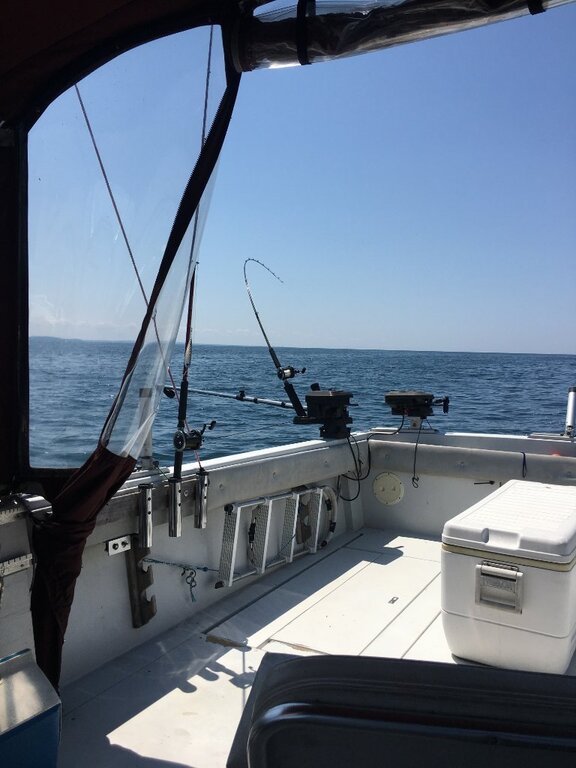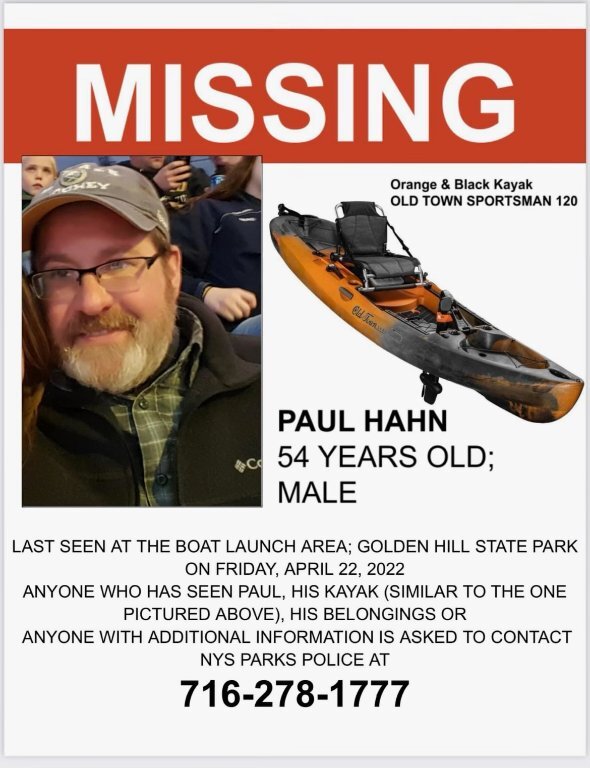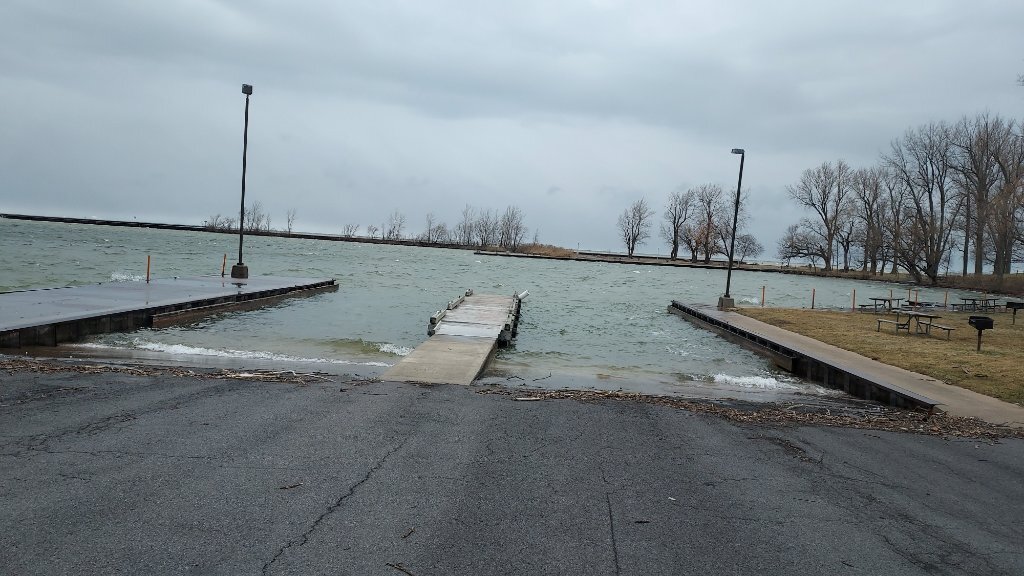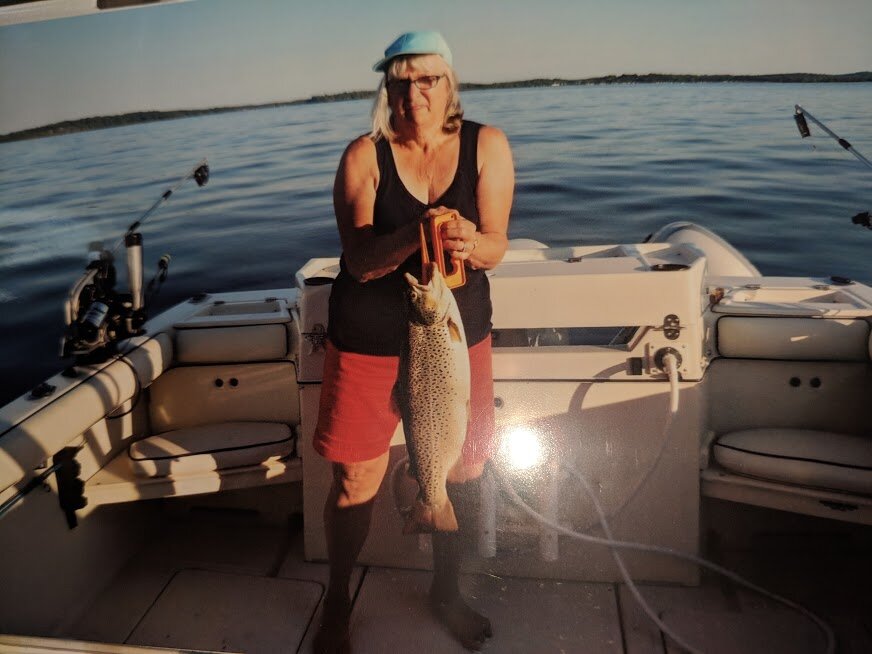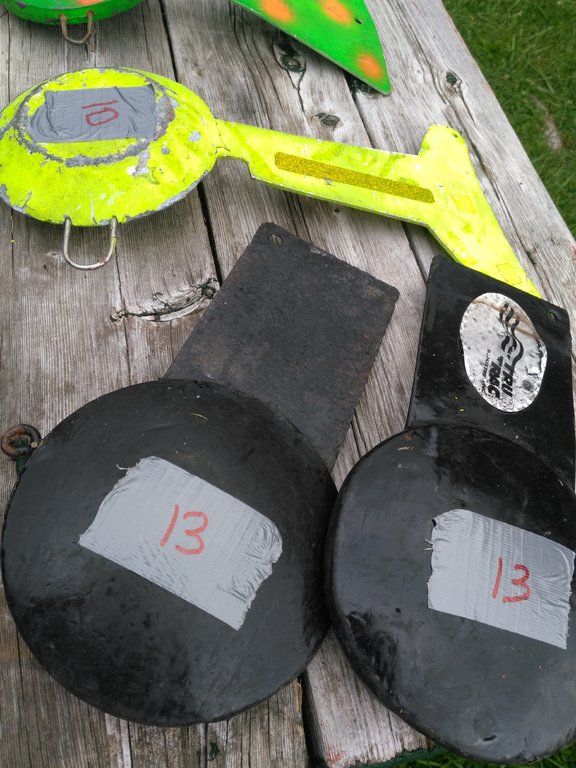-
Posts
203 -
Joined
-
Last visited
Content Type
Profiles
Forums
Events
Gallery
Store
Everything posted by Morgan-E
-
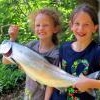
ELOSTA Meeting June 15th with Guest Speakers from the DEC
Morgan-E replied to Tall Tails's topic in Open Lake Discussion
Hoping to see many old and new faces. Lots of good, clean, fat, healthy alewives this weekend - looking forward to the preliminary trawl data. -

for sale : usa FOR SALE Penn Yan 1989 26ft
Morgan-E replied to George Salvato's topic in Boats for Sale
-
-
All are invited to the meeting tonight at the Mexico VFW (meetings are open to the public). The meeting will start at 7PM and will be inside the main building. There will be updates about the lake fishery counsel made up of lake and tributary anglers, hopefully some word on cormorant control, stocking, fishing reports, etc... Hope to see you there. Phil
-
Looking forward to seeing a lot of familiar and new faces this weekend.
-
ELOSTA will have a raffle or 50/50 as well. Donations can always be made to help send kids to DEC camp through ELOSTA too. Looking forward to the event. Thanks Phil
-
It will be at the Mexico VFW on April 9th morning until early afternoon. Entry fee will be a nominal $2 per person. There is an indoor and outdoor venue (if needed) for vendors. Tables are available for a fee (depending on the number of tables, size of the table, and possibly an outside versus inside rate). Exact times, food, and other information will be added as it gets firmed up. We already have a few vendors looking to unload a lot of stuff. There are plenty of tables still available. Please call Bill Pingel to get a table at 315-515-8278.
-
Next Wednesday, June 16th, ELOSTA (Eastern Lake Ontario Trout and Salmon Association) will be having a public meeting at the Mexico VFW on Route 13 at 7:00PM. All members and non-members are welcome and encouraged to attend. Topics will range from the bait fish situation, cormorants, fishing thus far, picnic / derby discussion for August, and other pertinent information as well as any techniques and or tips people are willing to share. Looking forward to seeing you there. Phil
-

Brewerton show
Morgan-E replied to sammygee's topic in New York Fishing Reports - Lake Ontario (South Shore)
It has been cancelled by the fire department last night due to the C-19 Sent from my Pixel 2 using Lake Ontario United mobile app -
A big shout out and thank you to the Salmon River Fish Hatchery Biologists and staff for the job that they do. After literally going every year and standing above the arena since the late 80's I was finally able to partake in what goes on down below. The perspective definitely changes when on the floor and many of the misconceptions that I did not realize I had have been cleared up BIG TIME. It is a whirlwind once the fish start coming and does not stop until the last one is spawned, research samples are collected and tallied, and everything is scrubbed down. There is a nice energetic and passionate group of young biologists and technicians who will make sure the hatchery fish continue to be of the highest quality. They all spoke with passion about what they were doing, studies they were taking part in, and fishing adventures they have had recently with the trout and salmon on the lake and in the Salmon and Oswego Rivers. One of the biggest misconceptions that I had as well as many of you reading this may have as well was that only the small males were being spawned. Not intentionally by any means!!!! From up high I could pick out the bigger ones that may have been overlooked or sent down a shoot or dumpstered without spawning. When at the sorting table it is fast paced and the fish in front of you is the one that goes into the tub to be spawned. Once there is a sufficient number in the tub the rest are discarded - big and small. We did some really nice males and a couple not so big males with most reflecting the average size coming up to the hatchery. What happens below the hatchery in terms of selecting out the biggest is outside of the hatchery's control and has been going on since the inception of the fishery. This was something that I had dreamed of doing and can't thank Tom enough for the opportunity. Unfortunately I was not able to put the eggs up due to cross country practice, but hopefully another time. My girls walked away with a whole new level of appreciation as well and Lizzy got a full blown milt mustache courtesy of a big chinook who was more than ready to go - if only I had a camera to take that picture to bring out when a new boy comes courting or for those special moments. Morgan who some of you know, said that if she wasn't going to be a physician assistant she would definitely be heading into fisheries biology -not only because of the fisheries, but the people who were on the floor with her. Thank you again for a Lake Ontario fishaholic's experience of a lifetime.
-

Bout Time Fair Haven Challenge
Morgan-E replied to bout time's topic in New York Fishing Reports - Lake Ontario (South Shore)
-

Fair Haven wounded warriors
Morgan-E replied to bout time's topic in New York Fishing Reports - Lake Ontario (South Shore)
Thanks again to everyone who helped out in making this another successful and meaningful event. The communication on the water was beyond excellent and definitely helped put more fish on the rods. It was cool too for the guys and gals to see the other boats with people they knew either going by or hooked up - lots of cheers and smiles. Congrats to the crew on board Outcast for catching the largest salmon at 24lbs even and on Blue Angel for catching the largest trout at 18 and 1/2 pounds. This is definitely one of the purest, most meaningful events that anyone could be a part of (large or small). Even the guys who struggled had veterans on board who were so grateful and were given an opportunity to feel at peace. More pictures can be found on the Fair Haven Fishing Association FB page with more to come. Sincerely, Phil -

Mr clean's Fair Haven Report
Morgan-E replied to mrclean's topic in New York Fishing Reports - Lake Ontario (South Shore)
Fair Haven Wounded Veterans Appreciation Weekend is fast approaching. It is and has been fast approaching. We now have solid numbers a week and a half out. There should be between 30 - 36 guys coming. Larry, Cindy, and I agreed that we could not turn these guys away who signed up after what they did for us (our goal is usually between 20 - 30) and are hoping for good weather and the fish to be biting regularly again. Spread the word that any one on the lake on the 22nd is encouraged to use channel 72 to spread the word on any patterns, depth, speed etc... that they get working to help bend an extra rod or two for these service men and women. Also, please be sure to thank all of the local businesses who have donated with special thanks to Bayside for allowing us to use their fish cleaning station, Turtle for hosting some of the guests in their cottages and opening up the restaurant early for breakfast and to be used as a meeting place to pair off with the captains, Screwy Louies for a cabin, Anchor for the use of their floating dock to help load and unload the guys with the high water, many of the restaurants in town and grocery stores for donations to the picnic, and countless others as far away as NJ who have donated trophies, plaques, money, and other goods. A special thank you as well to the local Legion for hosting the Friday night dinner for captains to share information and for the guests staying over night to have a place to go for a great spread and to get to know each other a bit better before a day of fishing. Thank you to all of the captains who have donated their time, expertise, friendship, and use of their boats to make this possible. Sincerely, Larry, Cindy, and Phil -
This Friday at 11AM the kings are scheduled to be delivered to the pens at Turtle Cove and Bayside Marina. Anyone able to come and help out would be greatly appreciated. If you can arrive a bit early 10:30-10:45 they get there early with the delivery sometimes. Usually everything goes smoothly, but some trouble shooting is needed some years. It is a great experience as fishermen to be a part of anyway and gets the blood flowing when thinking about what these little guys will turn into. Thank you in advance. Phil
-

Sold / Closed Arima 22 Sea Legend HT with 200hp E-Tec etc... $52,500
Morgan-E replied to Morgan-E's topic in Boats for Sale
-
If anyone is available we will be having a work day this Saturday at 1PM on the northern property of Bayside Marina to put a new net on one of the pens and secure the other nets on the other two pens. A pair of pliers with snips, boots, and gloves are recommended but not required. We will be having our FHFA meeting at the conclusion of the work where all are welcome. The pens will be docked at Turtle Cove and Bayside Marina again this year. Please be sure to thank Scott and Brian for their continued support. Also the DEC purchased this new net and two new feeders for this year and an additional net for next year for us. It may be raining so dress warm. Turtle Cove restaurant is open from Thursday through Sunday for dinner through close if anyone is looking for a bite to eat after. Thanks in advance.
-
This is just for thought and I do not claim to know for sure or have access to data to fully support or refute what is written below. It will take a little bit of time to read and digest. Something to chew on. Also note that the DEC biologists have read this and are looking at data relative to the thoughts below - thank you to them. The Scientific Answer / Cause of Reduced Chinook Size in Lake Ontario? Background: A recent study was concluded and published by the University of Helsinki and published in Sustainability News, “Salmon are Shrinking and it Shows in Their Genes” on November 14, 2018. This study was conducted on Atlantic salmon using 40 years of genetic material and concluded that the “gene version that tells salmon to mature at a later age and thus grow bigger is becoming less common, while the version that urges them to hurry up and get on with it is getting more prevalent.” Two alleles have been identified and the one that urges the salmon to mature earlier has become overwhelmingly dominant in the population while the allele that has been dominant in the past has become increasingly scarce. The theory behind the age and size shift is “that the salmon today are more likely to die during their time at sea either because of fishing or other reasons, and would thus benefit from returning to the rivers to spawn sooner rather then later”. Genetic Ties: Many times other factors are thought to influence the size of fish and may in fact do so over a very short period of time such as temperature, hormones determined by photo period, food availability, illness, competition, and others. However, in Lake Ontario there has been a noticeable decline in size using the derbies and individual observations over the past three decades. It was probably occurring prior to this but there were still enough large fish to make it unnoticeable. If it is indeed linked to genetics as it has been shown to be in Atlantic salmon it is an evolutionary change and not an environmental phenomena, meaning it is here long term and would take a shift in the allele (gene version) frequency to shift the trend. Lake Ontario Trends: The Lake Ontario salmon have been getting smaller over the decades but not due to bait fish availability. If it was tied to baitfish availability the fish would resemble the emaciated salmon of Huron and Michigan, but the “plumpness” of the salmon has remained relatively constant since it was first used as an indicator of fish health. This has remained the same while the overall size of the average fish has declined in the lake and the upper size expectancy has continued to decline. In the 1980’s people would expect to catch salmon in the upper 30’s and hope to catch one over 40lbs. This declined to expecting to catch fish over 30 and hoping to catch one in the upper 30’s in the 90’s. This has continued to decline to the present day where people expect to catch salmon in the lower 20’s and are hopeful to get one around the 30lb mark. At the hatchery the age structure of the fish has also shifted over the years and the average size has shifted down but not by as much as shown in the creel census, angler observations, and the lake-wide derbies. The explanation for this may be due to the constant fishing pressure on the Salmon River since the inception of the fishery. This will be discussed further in the artificial selection and adaptive value of the smaller / earlier maturing allele phenotype. On the Canadian side they have also seen a shift in the salmon size, but it has been a slower decline than on the U.S. side, but seems to have caught up to, or shows no real significant difference in reported observations. This may be tied to the lower tributary fishing pressure their fish have experienced when compared to the Salmon River. Again, this will be discussed later. In more recent history there have been greater highs and lows in the fishery that would suggest a single year determination in terms of year class rather than a subtle shift if multiple year classes were available to compensate for a single age class failure. Selecting agents giving adaptive value to maturing earlier rather than later: Lake-wide angling pressure will select against the salmon that are in the system longer by giving anglers an extra year or two to catch and remove the fish prior to spawning. Early in the fishery anglers knew that fish of like size tended to school together so they would leave the “smaller 20lb fish” in search of schools of larger fish. Any fish in the 80’s and early 90’s under 20lbs was considered small. However, these small fish that were not targeted or in many cases released in pursuit of larger salmon to fill the creel limit were the two year old fish. In the first decades of the fishery the larger fish were genetically selected against and the smaller fish were genetically selected for, increasing the frequency of the smaller, early maturing salmon. This was and is true for the entire lake regardless of where the salmon was spawned and or stocked. Tributary angling pressure has always selected for the largest of the salmon on the U.S. side. Early in the fishery to the present the largest most visible salmon have had a skewed amount of fishing pressure when compared to the less visible and less desired smaller salmon. Again, the largest are targeted because it is human nature to want the largest fish to fill the creel limit for a number of reasons. This greatly reduces the percentage of the 4 and 3 year olds successfully spawning by natural means or making it into the hatchery system. Within the hatchery there is a much smaller percentage of large fish compared to the number in the lake and that enter the mouth of the Salmon River. This may also be an explanation of why anglers accuse the DEC of spawning only the “small” fish (that is mostly what has and continues to be available within the spawn house). The slower fall in size on the Canadian side may be due to less pressure to no pressure on the tributaries compared to the U.S. side. The Canadian fish are still exposed to the same lake pressures which have had them decline in size and age structure, but without the tributary pressure the allele shift has taken longer and they have not had the extreme shift in fishing quality until recent years that the U.S. side has experienced. The natural wandering (around 10% from natal waters) would also allow the influx of the early maturing allele into waters where the late to mature fish may have otherwise maintained a genetically isolated population (namely in the clean tributaries of Canada where there has been reports of natural reproduction occurring for quite some time). Chinook compared to Atlantic salmon: Atlantic salmon may have actually taken longer to get to the point where the salmon are maturing early compared to the Chinooks. Since Atlantics spawn multiple times and can live up to seven years on average the “older” alleles should persist longer when compared to a fish that spawns only once. An Atlantic that manages to have good behavior and high fitness that happens to mature at a later time could spawn multiple times with fish that may have spawned for the first time at age two. This would allow the alleles to persist in a higher frequency than those of chinooks where the fish dies after spawning and has only a two, three, or four year old spawning allele. The shorter life cycle of the chinook compared to the Atlantic salmon makes it a better candidate for evolution than the slightly longer lived and slower to mature Atlantic salmon. Those species with shorter life cycles and higher reproductive potential are able to evolve more quickly to changes in the environment or selecting agents. Additionally the fishing pressure on the lake is far more concentrated for the entire life of the chinook in the lake system compared to the open ocean environment of the Atlantic salmon. This is based on the simple size of the area available to forage and disperse and with the new technologies and information sharing on the internet of fish location within the lake system. If the fishing pressure of the modern day has indeed influenced the genetic shift of the Atlantic salmon, then the chinook salmon should respond in a similar and more rapid shift due to the more acute fishing pressure experienced. Chinook compared to coho salmon: Coho salmon spawn at age two consistently. The size of the coho has not varied much from their introduction to Lake Ontario on a decade to decade average basis. A big coho in the 80’s was in the teens and today a big coho is still in the teens with the average mature fish being in the upper single digits to lower double digits. The very large infrequent coho of the past may have been undocumented hybrids. Some very large verified hybrids are still being taken out of the lake on occasion. Coho have not had the heavy selecting pressures placed on them that the chinook have been exposed to. They are seldom targeted in the lake (mostly an incidental catch) and are overlooked in the river when swimming amongst chinooks. This may be why there has not been any “need” to change as a species. Chinook compared to brown trout: Brown trout have remained relatively consistent over the decades with expected above and below averages in numbers and size. The brood stock has not changed in decades and that has lead to survivability issues and genetic health related problems, but those are not associated with human pressures on the lake or tributaries. The browns that successfully spawn may have changed behaviors as well due to fishing pressure in the lake and especially in the tributaries. This may be why tributary anglers are not seeing the brown trout that they have in the past (they too have changed their behavior and regardless of regulations or stocking numbers they may not return to the tributaries the way they did in the past in number or duration). Fishing success on the lake is tied to weather conditions more than anything in the Spring. The number of brown trout is highly influenced by predation at stocking, health of the trout including their size at stocking, and in some parts of the state poaching of brown trout in small tributaries has been reported. Chinook of today compared to the chinook of the past: The chinooks of Lake Ontario have already been identified as likely being a new subspecies through evolution of the species in terms of behavior compared to the original population from which they came. The fish do not stage as they did back in the 70’s through the mid 90’s in front of the river mouth. Instead their behavior is so erratic that they cannot fit any known models used to predict salmon migrations and staging behavior. Once in the tributaries they no longer spend a lot of time pool hopping as they used to, but instead swim to the hatchery or upper parts of the river and its tributaries in quick fashion. The chinooks used to be in the rivers in high numbers around Labor Day weekend, but these fish would have been exposed to higher and longer fishing pressure while waiting for optimal spawning temperatures a month away (their alleles have too been likely removed). Instead there is a massive run that occurs later in September and closer to the time of which they are able to successfully spawn. In the lake, the salmon move in and out of Mexico Bay and have staged in water as deep as six hundred feet in recent years off of Oswego which was unheard of or unknown of in the past. The chinooks are spawning at an earlier / smaller size than they did in the past only by percentage. It is likely that there were some that did in the beginning, but no one noticed or cared because they made up such a small percent of the total population. It is also likely that some behaved as erratically as those of today, but again they represented a very small percent of the population. In both of these instances their relatives that behaved in a traditional and known way were exposed to far greater pressure and had a greater likelihood of being removed prior to spawning. What does age two chinooks mean to the future of the fishery: Smaller fish similar to what we have been catching over the past two years will become the new normal. There is no reason for the chinooks to be selected to go back to the larger, older size class in any large percentage without artificial selection at the hatchery, a trophy class limit on anglers, reduced pressure on the tributaries of spawning fish, or new genetics being introduced from their ocean cousins. Greater uncertainty of the fishery from year to year will occur because the majority of the fish available and targeted as mature salmon will be represented by a single year class. If the lake trout population goes up so does the predation of the salmon stocked or that are wildly produced and the number of available salmon will decrease. Also, natural spawn becomes that much more important as the stocking numbers at the hatchery have decreased. If there is a poor natural reproduction year class the fishing will be directly tied to it. This makes the net pen projects that much more vital to the long term success and stability of the fishery. The predatory biomass of the chinook may be represented by smaller fish that are removed from the system a year or two prior to the past. This may require the alteration of the models used to project alewife consumption and sustainable stocking target numbers for these fish. A “cushion” fishery may need to be developed or developed further in the event of a year or two of poor survivability of the chinooks to sustain the economic fishery for the businesses that depend on the Lake fishery. This may be increased brown trout stocking, new strains of brown trout to offer true trophy size fish, increased coho stocking once the study concludes concerning which size class is most successful, or some other out of the box thinking to address this real situation. This may partially explain the very low success of the fishing in 2014 to 2015 and the very high success in 2017 and 2018. With the shift to primarily two year old chinooks the low fishing followed a higher lake trout population. With the lower salmon fishing conditions the focus of many anglers shifted to lake trout and their numbers fell. This lowered the predation of chinooks and with high natural spawn the exceptional fisheries of the past two seasons occurred. In conclusion: The study on Atlantic salmon may reveal an answer to a lot of the trends in the Lake Ontario fishery concerning the chinook salmon over the past three decades. It may also show where the fishery is heading. If there is a follow-up study to this on the lake or if data that has been collected at the hatchery and through the creel census supports this occurring in Lake Ontario, work will need to be done to correct many of the models used today that were developed around the “old” chinook. In addition a re-education of the anglers and the expectations of the angling community may need to occur. There may be numbers of large salmon from time to time, but it may be linked to less than ideal conditions not allowing the salmon to mature at age two as they would if they were healthy. The greatest indicator of the overall health of the salmon may continue to be the plumpness of the 36” fish rather than the overall average size of the fish as the genetics may not allow for this to increase again. More attention will have to be given to each year class of fish since there will not be a noticeable buffer class to make up for a failed year class as there has been in the past. For Review; Phil Lucason
-

Sold / Closed Arima 22 Sea Legend HT with 200hp E-Tec etc... $52,500
Morgan-E replied to Morgan-E's topic in Boats for Sale
-

Sold / Closed Arima 22 Sea Legend HT with 200hp E-Tec etc... $52,500
Morgan-E replied to Morgan-E's topic in Boats for Sale
-

Sold / Closed Arima 22 Sea Legend HT with 200hp E-Tec etc... $52,500
Morgan-E posted a topic in Boats for Sale
Arima Sea Legend 22 Hard Top with 200hp Evinrude E-tec (less than 100 hours) and 15hp Honda kicker (around 250 hours) set up for Lake Ontario Salmon and Trout Fishing. This boat has a lifetime warranty with no wood in the construction to rot (see the Arima website). This is the largest of the highly sought after and respected Arima fishing boats. As of 2015 there were only around 50 of these models made since 1999. The hull is designed to get on plane at low speeds, has a sharp bow entry to cut through the chop rather than bouncing over it, deep gunnels for safety, a wide beam (almost 9') that has little taper to the water line for tremendous stability, factory molded kicker bracket, fish wells, rod storage, a cuddy cabin to get out of the elements and store gear, porta-potty, dual batteries, wash down system, storage compartments everywhere, rocket launcher on the roof, jump seats in the back, large rear deck with ample room for rigging, fighting fish, and netting fish, a Pacific designed hard top with a significant front overhang for rain and sun, nonskid deck, 100 gallon fuel tank, grab rails on the roof, SS bow rails, swim platform, docking canvas, drop curtain, and factory applied bottom paint (when you look at the paint it is easy to see how little the boat has been used and how well it has been cared for). This boat is also equipped with Lowrance radar, a 10" HD Lowrance fish finder/GPS unit, VHF radio and antenna, fine throttle control remote for trolling, easy steer connection between the two motors. It also comes with dual batteries, 2 hardly used Big Jon downriggers, and new trim tabs. The E-tec and Honda have hardly been broken in. Even with the little use, the Honda has been serviced every year and the E-tec has followed the service protocol as recommended by what is done on a year to year basis since the hours have never been met. Even though this is a 2011 it was not used until 2012 and missed the 2017 season due to the extremely high water making the dock situation less than ideal for two elderly fishermen. It has only been used from June through Labor Day each season and has been barn (clean rodent free) stored the rest of the time. This is the ultimate under 24' big water fishing machine with a well thought out layout, superior hull design, safe deep gunnels, and plenty of room to enjoy the day. This also includes a dual axle 2011 Tidewater trailer. It has been easily towed by a Mercury Mountaineer (Ford Explorer) and even easier by a F150. I am listing this for my two parents who have reached the point where it has become more enjoyable to fish on younger anglers' boats. This is as close to a new Arima 22 Sea Legend HT that you can get without paying the new price of around $110,000 when similarly outfitted. The boat is located in Fair Haven, NY. They do not have a computer so please contact them by phone at 315-652-2141 - my Dad's name is Pete. (they do not have a computer so please call them - they will not see questions here on the thread) -

for sale : usa Brewerton NY ELOSTA Flea Market
Morgan-E replied to just me's topic in Classifieds - Buy, Sell, Trade or Rent
Werner Stenger "Popeye Charters" out of Fair Haven is also scheduled to do a seminar (not sure if it will be on brown trout or salmon or both). Sent from my Pixel 2 using Lake Ontario United mobile app -

for sale : usa Pancake downriggers weights
Morgan-E replied to just me's topic in Classifieds - Buy, Sell, Trade or Rent
-

Another 20% CUT in Chinook Stocking for 2019
Morgan-E replied to Tall Tails's topic in Open Lake Discussion
Many associations along the southern shoreline are directly opposed to this additional cut for many solid reasons. The Fair Haven Fishing Association is directly opposed to the proposed additional cuts after careful thought and many messages, phone calls, discussions, and emails. The official letter can be found on the Fair Haven Fishing Association Facebook page at the bottom of the most recent post. Many anglers who fish the lake are gone at this time of the year and will not be able to make the meeting, but took the time to make their opinions, observations, and concerns known. -

Fair Haven 8/11
Morgan-E replied to bout time's topic in New York Fishing Reports - Lake Ontario (South Shore)
-

Mr clean's Fair Haven Report
Morgan-E replied to mrclean's topic in New York Fishing Reports - Lake Ontario (South Shore)


